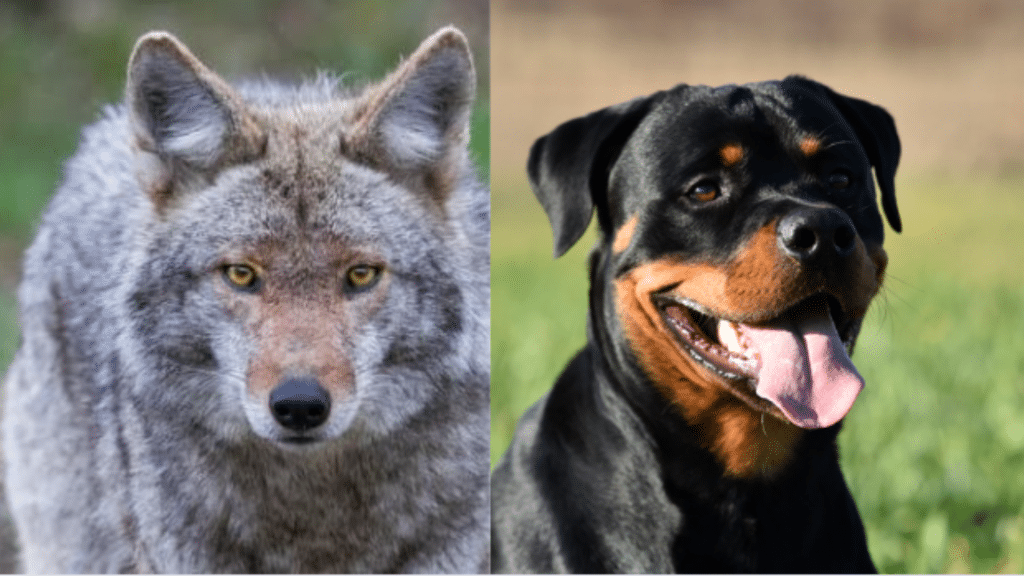It’s not every day you think about a dog and a wild animal crossing paths, but in some places, it happens.
Imagine you’re out on your land or walking your dog, and suddenly, a wild animal shows up. That’s when you start to wonder. What would your dog do?
This blog takes a closer look at two different animals: one raised to guard and protect, the other made for surviving in the wild.
We’re not just guessing; we’re looking at real traits and instincts and how they react in unexpected situations.
If you’ve ever been curious about these rare encounters, you’ll find some clear answers here.
Rottweiler vs Coyote
Rottweiler vs. Coyote presents a surprising clash between a powerful domestic guardian and a cunning wild predator in real-world encounters.
- Rottweilers: Rottweilers are large, muscular dogs known for their loyalty, confidence, and strength. Originally bred for herding and guarding, they remain naturally defensive and quick to respond when danger approaches.
- Coyotes: Coyotes are adaptable wild canines found across North America. Slim and quick, they depend on sharp senses and smart decision-making. Often traveling in pairs or groups, they navigate challenges with caution and creativity.
Physical Comparison of Rottweiler vs Coyote
| Trait | Rottweiler | Coyote |
|---|---|---|
| Average Weight | 80–135 lbs | 20–50 lbs |
| Average Height | 22–27 inches | 21–24 inches |
| Bite Force | 328 PSI | 88- 153 PSI |
| Temperament | Loyal, confident, protective | Wary, cunning, opportunistic |
| Pack Behavior | Not natural pack hunters | Often hunts in pairs or small packs |
| Lifespan | 8–10 years | 10–14 years |
Can a Rottweiler Beat a Coyote in a Fight
In a one-on-one fight, a healthy adult Rottweiler has a clear physical advantage over a coyote. Their thick build and protective instinct make them formidable opponents.
Coyotes, on the other hand, are lean and agile and more accustomed to fleeing or fighting in packs rather than solo combat.
While a Rottweiler could usually overpower a lone coyote, the situation changes if the coyote is part of a pack.
Coyotes are smart and quick. When they work together, they can easily outmatch even a strong dog.
How things turn out depends on the situation, the landscape, and the animals involved.
Strength vs Strategy of Canines
When these two very distinct animals cross paths with one another, one brings raw power while the other relies on its brain and fast reflexes:
1. Rottweiler’s Strength-Based Traits
This dog doesn’t back down when something threatens its space or family.
- Uses direct, powerful confrontation in conflict
- Protective and confident when facing threats
- Best in short, intense bursts of energy
- Reacts with force more than speed
- Acts solo or with human guidance
- Likely to win in one-on-one fights
2. Coyote’s Strategy-Based Traits
Coyotes survive not through strength alone, but through smart decisions and well-timed moves.
- Fights with quick attacks and retreats
- Relies on speed, awareness, and planning
- Cautious but smart about when to fight or flee
- Built for long chases and endurance
- Extremely alert and reactive to movement
- Works in pairs or packs for advantage
- Wins by outsmarting or overwhelming opponents
How Do Coyotes Usually Behave Around Dogs
Coyotes usually avoid large dogs like Rottweilers and keep their distance. They’re not looking for fights — they’d rather move through unseen and unheard.
However, when food is limited or young pups are nearby, coyotes may act more daring. They’ve been known to test boundaries from a distance or use distraction tactics, especially in groups.
While they usually choose to flee, coyotes in areas with frequent human contact may become bolder over time.
It’s crucial to supervise dogs outdoors, regardless of size.
Signs a Rottweiler Might Chase or Confront a Coyote
Some Rottweilers are more reactive than others, but these warning signs often mean the dog is preparing to act:
- Fixed staring at the coyote’s movement
- Raised hackles along the back
- Deep growling or focused barking
- Muscles visibly tensed and alert
- Guarding actions like circling or blocking
- Sudden lunging or leash-pulling toward the threat
- Refusal to back off, even if the coyote retreats
- Upright tail, signaling alertness or dominance
- Pacing or anxious movement when sensing a nearby threat
If you see any of these, it’s best to stay calm, call your dog back, and avoid escalating the encounter.
Interesting Facts About Rottweilers and Coyotes
Here’s what makes both animals unique and impressive in their own ways:
Rottweilers
- Roman cattle dogs: Originally used in ancient Rome to herd livestock and pull carts.
- Happy grins: Some Rotties flash a toothy “smile” when excited — goofy, not aggressive.
- Multi-talented: They’re great at protection work but also shine as emotional support animals.
Coyotes
- Urban survivors: Found in deserts, forests, suburbs, and even golf courses.
- Talkative by nature: Use a mix of yips, barks, and howls to communicate across distances.
- Team players: Use clever decoys and flanking moves to catch prey or distract threats.
Conclusion
Rottweilers and coyotes may both be canines, but they are shaped by totally different worlds — one by close bonds and loyalty, the other by the sharp demands of nature.
However, in a fight, the Rottweiler’s build and instinct give it the upper hand. But real-life scenarios rarely follow simple rules. Packs, surroundings, and timing all play a role.
Rather than focusing on who wins, the best lesson is how to stay aware and avoid conflict.
When you know how these animals behave, you’re one step closer to keeping everyone — wild or tame — safe.























